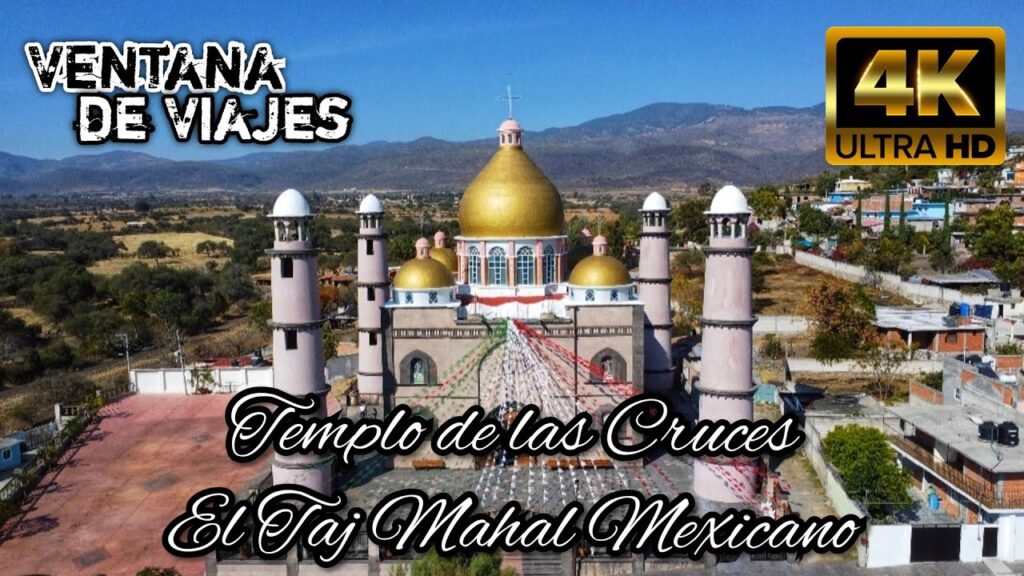Discover Mexico’s Taj Mahal: The Intriguing Church of Guanajuato
Stepping into the city of Guanajuato, visitors are immediately enveloped by a sense of history and romance. Nestled in the heart of Mexico, Guanajuato’s cobbled streets, colonial architecture, and vibrant colors set the stage for a remarkable discovery. Among its many historical treasures, there is one lesser-known jewel often referred to as Mexico’s Taj Mahal – the enigmatic Church of Guanajuato.
The Church of Guanajuato, formally known as the Templo de San Cayetano or La Valenciana, stands majestically on a hill overlooking the surrounding landscape. Built between 1765 and 1788, its construction was funded by the wealth of the adjacent La Valenciana Silver Mine. This opulent place of worship was designed to showcase not only the spiritual fervor of the time but also the incredible wealth that the silver mines brought to the region.
Breathtaking is an understatement when describing the grandeur of the church’s interior. The altars, meticulously covered in gold leaf and adorned with religious iconography, reflect a brilliance that rivals the sun itself. The intricate frescoes and oil paintings tell stories of faith and legend, inviting visitors to lose themselves in contemplation and awe. Each element within the church, from the lavishly decorated chapels to the elaborate chandeliers, echoes the excesses of the colonial era.
Yet, beyond its sheer physical beauty, the Church of Guanajuato holds a deeper significance for those interested in the cultural syncretism of post-colonial Mexico. It stands as a testament to the blending of indigenous artistry and European Catholic influences, epitomizing the complex tapestry that is Mexican history. Visitors can observe the unique fusion of styles in the architectural and artistic details that breathe life into this extraordinary structure.
The Church of Guanajuato’s comparison to the Taj Mahal is not solely in its grandeur but also in its embodiment of a remarkable love story. While the Taj Mahal was built by an emperor in memory of his beloved wife, the Church of Guanajuato was erected as an expression of gratitude by a miner who struck fortune, as if the silver from the very earth was an act of divine favor. This connection adds an emotional depth to the church that resonates with the tales of passion and devotion that are woven into the very fabric of Guanajuato.
A Unique Blend of Architectures: Guanajuato’s Mosque-Like Church
In the heart of Mexico, amidst the rolling hills and vibrant cultural tapestry, lies a gem of architectural fusion that beckons travelers from near and far. Guanajuato, a city renowned for its colorful streets and rich history, is home to the extraordinary Templo de San Diego, a church that stands out for its distinctive mosque-like appearance. This remarkable structure is a visual testament to the diverse influences that have shaped the region over centuries.
The church’s architecture is an intriguing confluence of Moorish and Mexican baroque styles, which is particularly evident in its arched windows and ornate facade. Unfolding its story layer by layer, visitors are struck by the unique minaret-inspired tower that soars above the cityscape. The design is uncommon in a predominantly Catholic country, which traditionally favors the cross-topped dome or bell towers on its places of worship. A closer look reveals intricate Islamic motifs intertwined with Christian symbolism, an unexpected encounter that holds the gaze of onlookers.
Inside, the harmony of cultural elements continues to amaze. The interior is a spectacle of light and shadow, playing off the geometrical designs that adorn the walls and ceilings. Bold patterns reminiscent of Islamic art create a serene atmosphere, inviting a moment of reflection amidst the bustling city outside. It is this remarkable fusion, alive in the very stones and mortar of the Tempo de San Diego, which speaks to a broader narrative of tolerance and the blending of traditions across time and borders. Visitors leave with a sense of awe for the ways in which art and architecture can bridge seemingly disparate worlds, creating a space as beautiful as it is thought-provoking.
Exploring the Beauty of Guanajuato’s Church: A Taj Mahal Experience in Mexico
Stepping into Guanajuato, a city that boasts a unique blend of history and artistry, one cannot help but be drawn to the intricate architecture and spiritual aura of its churches. Among these, a particular church stands out, not just for its historical significance, but for its breathtaking design that conjures images of the famed Taj Mahal. This architectural marvel, with its ornate carvings and majestic spires, offers a window into Mexico’s colonial past and its fusion with indigenous art forms.
The church’s façade is a tapestry of stone that tells stories of faith and culture, with each detail meticulously crafted to perfection. The grandeur of the primary portal, adorned with elaborate stonework reminiscent of the delicate inlay and marble of the Taj Mahal, invites visitors to a serene experience akin to that of India’s crown jewel. Inside, the beauty only intensifies, with gold-leaf altarpieces radiating in the ambient light and captivating frescoes that adorn the lofty ceilings, beckoning the eyes upward in silent reverence.
For the adventurous soul, the church and its surroundings offer more than just visual splendor. It is a starting point for a deeper exploration into Guanajuato’s rich tapestry of history. From the bustling marketplaces that surround the church to the winding, cobblestone streets that lead to hidden plazas and colorful houses, visitors can immerse themselves in a cultural expedition. Each step taken around this magnificent edifice is a step through time, bridging the gap between the ancient world and the modern era, much like how the Taj Mahal transcends history and continues to captivate with its timeless allure.
The Architectural Marvel of Guanajuato: A Church Resembling a Mosque
Amid the rolling hills and vibrant streets of Guanajuato, a city renowned for its colonial architecture and colorful alleyways, stands an unusual structure that captivates visitors with its remarkable design. This is not your typical Mexican church. Rather, it is a testament to architectural experimentation and cultural fusion, reminiscent of the grand mosques found in faraway lands. With its large dome and arched windows, this building blurs the lines between a traditional Catholic church and an Islamic place of worship, offering a unique spiritual haven for those looking for an extraordinary religious experience.
The church’s intricate facade, adorned with geometric patterns and muqarnas-like details, echoes the artistic intricacies characteristic of Islamic architecture. The use of light and shadows, combined with the ornate decoration, gives the building a mysterious and otherworldly appearance, especially at dawn and dusk when the warm glow of the sun kisses its surface. The design choice is both a bold statement and a nod to the universal language of architectural beauty, which transcends cultural and religious boundaries, inviting people of all faiths to ponder the divine.
Within its walls, the church provides an atmosphere of tranquility and reverence. The vaulted ceilings rise to the heavens, and the acoustics create a serene environment for reflection and prayer. Venturing into this space, visitors are often struck by the harmonious blend of styles – the Christian iconography interspersed with motifs that wouldn’t seem out of place in the courtyards of Córdoba’s famed la Mezquita. This church is not just a place of worship, but also a celebration of humanity’s quest to express the ineffable through architecture – a jewel in Guanajuato’s already impressive crown.
Unveiling the Mysteries: Guanajuato’s Church as Mexico’s Taj Mahal
Delving into the heart of Mexico’s vibrant cultural tapestry, the city of Guanajuato emerges as a treasure trove of colonial architecture and historical significance. At the pinnacle of its aesthetic allure is the Basilica Colegiata de Nuestra Señora de Guanajuato, often likened to India’s iconic Taj Mahal for its intricate design and profound symbolic stature. This comparison not only highlights the universal appeal of grand religious structures but also marks Guanajuato’s church as a landmark that encapsulates the essence of Mexico’s enigmatic past.
Constructed over a period spanning three centuries, this basilica stands as a testament to the dedication and artistry of the local populace. Its luminous yellow and red facade captivates viewers, casting an ethereal glow over the city’s bustling streets and quaint alleyways. The church’s extravagant baroque style and the detailed work on its entrance bear a striking resemblance to the Mughal architecture of the Taj Mahal, albeit on cobblestone lanes, surrounded by the rolling hills of Central Mexico.
Inside, the church houses an impressive collection of art, including a revered image of the Virgin Mary, which, according to local lore, was donated by the King of Spain himself. This sacred artifact cements the basilica’s cultural and religious importance, drawing parallels to the Taj Mahal, which was built as a mausoleum to enshrine the beloved wife of a Mughal emperor. Both structures serve as symbols of devotion, imbued with stories and sentiments that transcend time.
Visitors to Guanajuato’s church are often struck by the awe-inspiring interior, adorned with gold leaf and elaborate frescoes that chronicle the life of the Virgin Mary. The visual narrative unfolds across vaulted ceilings and domed interiors, a spectacle to rival the intricate pietra dura inlays and marble craftsmanship that immortalize the Taj Mahal. The basilica’s purposeful artistry mirrors the love and reverence poured into the Indian mausoleum, despite their divergent cultural contexts.
The mysteries enshrouding Guanajuato’s church extend beyond its architectural feats to its enigmatic underground tunnels that weave through the city, reminiscent of the Taj Mahal’s complex of structures and gardens. These hidden passageways tell a story of a city that thrived on silver mining, hinting at the untold wealth and power that once flowed beneath its soil, much like the opulence the Taj Mahal emanates on the banks of the Yamuna River. Such parallels between Guanajuato’s basilica and the Taj Mahal offer a fascinating glimpse into two world’s architectural marvels, forever etched in stone and spirituality.



